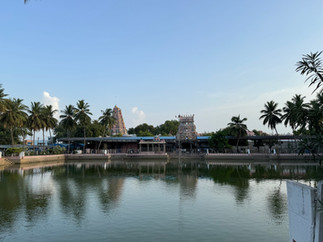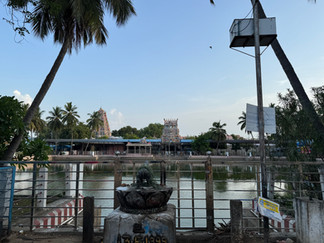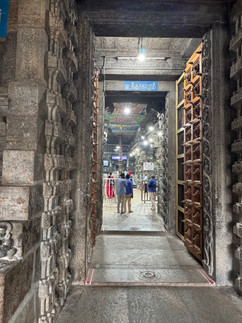Temples of Tamil Nadu and Pondicherry #92: Karpaka Vinayakar Temple, Pillayarpatti
- Sudharshan
- Aug 23
- 3 min read
Updated: Aug 26
கற்பக விநாயகர் திருக்கோயில், பிள்ளையார்பட்டி
One of the oldest temples to Lord Vinayaka or Ganesha in the Tamil country, this temple is very ancient. Lord Ganesha is fondly referred to as Pillayar in Tamil. It is a cave temple. Its origins are shrouded in the mists of time. Although the temple is best known as a Pillayar temple, like most Saivite temples, Lord Siva is also given great prominence. There are two main sanctums at right angles to each other. They are both accorded equal importance, although the Vinayagar cave-shrine is by far the more popular.
The layout of the temple is unique in that there is a cave shrine built into the rock face of the hillock behind the temple and is enclosed within the temple. This is the most ancient part of the temple and faces north with an entrance in that direction with a rajagopuram of its own. It houses a rock-cut, large idol of Lord Ganesha facing north. It also houses other sculptures including Lord Sivan in the form of a lingam called the Thiruveesar. At right angles to it is an east facing structural shrine housing Lord Siva as a lingam and is known as the Marudeeswarar. Here the Lord faces east and there is an entrance and a rajagopuram in that direction also.
The age of this temple is somewhat difficult to date exactly. The rock cut idol of Pillayar and other idols in the cave shrine appear to be quite ancient. There is an inscription at the bottom of the idol which is a name of a person and widely believed to be that of the sculptor. A signature of sorts. The Tamil script is that which prevailed in the 2nd to 5th centuries. Based on this scholars have dated the cave to the 4th century. There are other clues dating it to the 7th century. It has been extensively renovated many times since then, constituting many phases of rebuilding. There is a 7th century inscription that names the Ganesha idol as Desi Vinayaka. Some have postulated that the Pallava monarch Narasimhavarman I built the cave temple around 650 CE. Others believe that it is more likely that the early Pandian kings were responsible. Although the Pallavas built similar temples in the northeast, it is unlikely that their direct influence extended this far south. There are also more recent inscriptions on the walls from 1091 and 1238 CE suggesting further expansions in those times. Since the 13th century onwards the Nattukottai Chettiar or Nagarathar community has actively patronised this temple and has been responsible for its further development and upkeep. It is celebrated as one of the nine ancestral temples of this merchant community.
The Pillayar idol within the cave is a magnificent bas-relief sculpted on the granite cave wall facing north. It is 6 feet tall and has been covered in glittering gold. Uniquely, the Thumbikkai or trunk of the Lord is curved to the right instead of the common left curvature. Thus he is called Valampuri Vinayagar. Moreover he only has two hands as opposed to the customary four. The other sculptures within the cave are also unusual. There is an enigmatic bas-relief of a figure with two attendants that has variously been described as a royal figure or Lord Shiva. If it is that of a royal patron, the headdress and attire do not fit the usual Pandian or Pallava styles. There is another figure which is asymmetric, leading to speculation that it is an early Ardhanareeswarar (half Sivan-half Parvati) or Harihara (half Sivan- half Vishnu), but the sculpture is not typical of either form. The structural Marudeeswarar shrine is built like a traditional sanctum with a vimanam and is a later addition. The sthala virutcham is the Marudam or Arjuna tree. It is one of four temples in South India where the Marutham tree is celebrated. The others are Thirupudaimaruthur, Thiruvidaimaruthur and Srisailam in Andra Pradesh.
Apart from its historical significance the temple is an important pilgrimage site and very popular among devotees. It draws large crowds of worshippers throughout the year. Festivals like the Vinayaka Chathurthi which usually falls in late August or early September are celebrated with great flair.
The temple is located in the village of Pillayarpatti, near Kundrakudi and Thirupathur. It is 80 km or 1.5 hours northeast of Madurai, 15 km or 30 minutes northwest of Karaikudi or 45 km or 1 hour south of Pudukkottai. We visited in July 2012 and June 2025. We were based in Kanadukathan.


Sources: Nagaswamy, R. “Some Contributions of the Pāṇḍya to South Indian Art.” Artibus Asiae, vol. 27, no. 3, 1965, pp. 265–74. JSTOR, https://doi.org/10.2307/3249074. Accessed 23 Aug. 2025.
P.K. Nambiar and K.C. Narayana Kurup (1961), Temples of Madras State, Census of India Volume IX, Part XI-D (vi), Government of India, pp. 196–198 https://archive.org/details/temples-of-tamilnadu/Book-Temples-of-Tamilnadu-Vol-6-Madurai-Ramnad-Census1961-648pp/page/n343/mode/2up

Credits: Google Maps















Comments